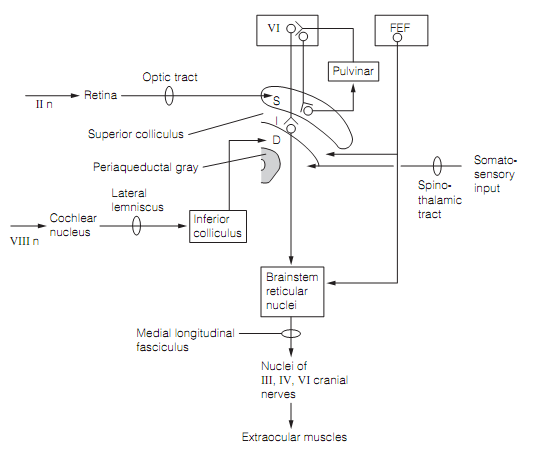Saccades
Saccades are rapid conjugate eye movements which move the fovea to target a different point in visual space. The saccade system employs auditory, visual, and somatosensory input to determine the eye rotation needed to realign the gaze. The horizontal saccades are controlled by the paramedian pontine reticular formation (PPRF) whereas vertical saccades are organized by the rostral interstitial nucleus that lies in the medial longitudinal fasciculus. Both of these contain burst cells that code for the size and direction of the eye movement and are excitatory to oculomotor neurons.The signals which trigger saccades come from the superior colliculus and the frontal eye fields of the frontal cortex. Each can produce saccades separately of the other.
The superior colliculus is separated into intermediate, superficial, and deep layers. The superficial layer obtains information from the retina and visual cortex and contains a map of the contralateral visual field. The deep layer gets auditory and somatosensory input and therefore contains an auditory map of the position of sounds in space and a somatotopic map in which the body sections closest to the eyes gets the greatest representation. The intermediate layers have a motor map. Neurons here are known as collicular saccade-related burst neurons as they fire a high frequency burst of action potentials around 20 ms before a saccade. Each one has a movement field (i.e., equivalent of a receptive field) which covers the sizes and directions of the saccades it participate in. The direction of any given saccade is encoded by a population of neurons in exactly the manner in which the primary motor cortex uses population coding to determine the direction of movements.
The better colliculus turns sensory coordinates into motor coordinates. All of its four maps are in register therefore each point on the superior colliculus represents a particular position in sensory space and the saccades essential to direct gaze towards it. Though, visual input to the superficial layers does not automatically lead to firing of cells in the intermediate layer. This is as superficial layer cells relay via the pulvinar of the thalamus and the visual cortex before influencing the intermediary layer cells. The relay might function to permit saccades only to stimuli with high salience and therefore is a visual attention mechanism. The figure is a diagram of the circuitry involved in saccades as shown below.

Figure: Circuitry for saccades. The superior colliculus has three layers: S=superficial; I=intermediate; D=deep; FEF=frontal eye fields; VI=primary visual cortex.
Additionally to generate saccades the superior colliculus causes head rotation, by the way of tectospinal tract, to neck muscle motor neurons. This permits orientation towards a stimulus, so called orienting responses.
The frontal eye field (FEF) triggers saccades directly by stimulating the intermediary layer burst cells in the superior colliculus, and operates the oculomotor basal ganglia-thalamocortical circuit to select suitable eye movements.
Damage to the superior colliculus causes temporary impairment in generating saccades. Recovery occurs as the FEF can trigger saccades by its direct connections with the pons and midbrain. Damage to FEF causes transient paralysis of gaze towards the opposite side, however reflex saccades soon return produced by the superior colliculus. Though, loss of the FEF prevents intentional saccades.